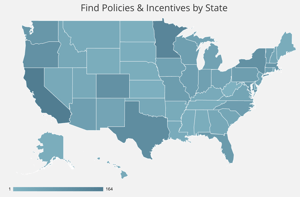 Across the United States, government bodies have legislation that dictates requirements to achieve financial incentives such as tax abatement, loans and grants, and permit expedition. Sometimes the incentives are for residential or commercial buildings only or include provisions for both types. Included among them are Cleveland, Cincinnati, Massachusetts, and Miami - and many others shown in this image and listed here (image credit from the Database of State Incentives for Renewables & Efficiency). In most cases, a sustainability component is embedded that requires projects to demonstrate performance such as carbon reduction, energy efficiency, and designs for healthy indoor environmental quality. In some cases, the requirements include achieving a green building certification, which includes criteria demonstrating the same.
Across the United States, government bodies have legislation that dictates requirements to achieve financial incentives such as tax abatement, loans and grants, and permit expedition. Sometimes the incentives are for residential or commercial buildings only or include provisions for both types. Included among them are Cleveland, Cincinnati, Massachusetts, and Miami - and many others shown in this image and listed here (image credit from the Database of State Incentives for Renewables & Efficiency). In most cases, a sustainability component is embedded that requires projects to demonstrate performance such as carbon reduction, energy efficiency, and designs for healthy indoor environmental quality. In some cases, the requirements include achieving a green building certification, which includes criteria demonstrating the same.
When it comes to residential projects, we encourage projects to evaluate which compliance path for its incentives makes the most sense. Every project has characteristics that make it unique. Whether it is a modern and innovative design, the adaptive reuse of a historic structure, or something in between, all housing projects have features that set them apart and make them unique. Similarly, every project has a certification path that best aligns with the goals of its owner and project team. Choosing the right path is critical to ensure the project realizes its design's vision, maximizes ownership value, and positively impacts residents, guests, staff, and the surrounding community. And, is able to attract the financial incentive.
As project teams sort through the ever-evolving menu of green building criteria, it can be overwhelming to decide which ones should be integrated into the design and construction of their project. Once chosen, the certification requirements will become embedded into the project’s core and will impact the decision-making process for the remainder of the project. Similarly, the certification costs, and any costs associated with project design revisions, must be absorbed into the project’s budget. Project schedules will need to account for certification-specific milestones related to the timing of the certification process and the incorporation of site visits for testing and verification. Choosing the right sustainable building certification path is critical and should be considered carefully and collaboratively. But how to begin?
To provide clarity to this seemingly opaque process, the following summarizes three sustainable building criteria commonly utilized by Emerald’s clients.
Leadership in Energy and Environmental Design (LEED)
 Considered to be the world’s most recognized green building standard, LEED provides a well-known framework to identify and implement sustainable building design, construction, and operations and maintenance strategies. Developed by the U.S. Green Building Council (USGBC), the LEED building certification system can be utilized for multiple building types, including residential, office, schools, hospitals, commercial interiors, and neighborhoods and cities. LEED’s BD+C rating system works for some multi-family buildings, whereas LEED for Residential Design and Construction is more applicable to low-rise multi-family and single-family homes.
Considered to be the world’s most recognized green building standard, LEED provides a well-known framework to identify and implement sustainable building design, construction, and operations and maintenance strategies. Developed by the U.S. Green Building Council (USGBC), the LEED building certification system can be utilized for multiple building types, including residential, office, schools, hospitals, commercial interiors, and neighborhoods and cities. LEED’s BD+C rating system works for some multi-family buildings, whereas LEED for Residential Design and Construction is more applicable to low-rise multi-family and single-family homes.
While the LEED certification costs are higher than other rating systems, the value of LEED is considerable in terms of building performance, operational cost savings, tenant attraction and retention, and market recognition. The pass-fail testing and verification protocols embedded in LEED Homes, NGBS, and EGC do not apply in LEED BD+C, which is a boon for some projects. Instead of blower doors and duct tests, LEED BD+C projects are commissioned. LEED’s versatility allows it to be applied to projects of all types and in all locations.
National Green Building Standard (NGBS)
Developed through a joint effort of ASHRAE (American Society of Heating, Refrigerating and Air-Conditioning Engineers), ICC (International Code Council), and the National Home Builders Association, NGBS is an option available to developers of single-family homes, mixed-use, or all residential multi-family projects. This standard was developed to align with the IBC (International Building Code), and, as such, many of its mandatory and optional credit items are directly applicable to existing building codes across the country.
NGBS offers project teams flexibility via a la carte credit selection as well as both prescriptive and performance compliance paths. Its on-site inspection by an NGBS Accredited Professional ensures rigorous adherence to criteria requirements, which may or may not be attractive to a project based upon scheduling. We see many of our projects easily able to achieve Bronze Certification with minimal additional effort or cost (other than 3rd party inspections and verification), so NGBS represents an attractive option for many projects. To achieve higher levels of certification, more investment is required and additional testing may be an option or required to achieve financial incentives.
Enterprise Green Communities (EGC)
Representing the only national green building rating system designed specifically for the affordable housing sector, EGC offers a clear framework for multi-family and single-family new construction, substantial rehab, and moderate rehab projects. Through a partnership with the International WELL Building Institute (IWBI), projects that achieve certification under Enterprise’s 2020 Criteria are also recognized as certified under WELL, the premier framework for advancing health and well-being in buildings.
EGC includes onsite testing and verification and requires that new construction projects certify under the appropriate version of Energy Star. Since it is designed for affordable housing projects, EGC has less versatility than other rating systems. That said, EGC represents a critical certification path for projects seeking to provide lower-income communities with quality, healthy, and sustainable homes.
Let Emerald Help You Find the Right Rating System
When it comes to building certification paths, one size does not fit all, so it is critical that project teams thoughtfully consider the components of each rating system at an early stage. Implementing any of the above rating systems will have significant ramifications for design, construction, budget, and more, so choosing the right path is vital to project success. Contact Emerald today to discuss which path is right for your current or next project.
There are many other certification systems and you can see their summaries on our website or download our Certification Primer HERE.
Posts by Tag
- Sustainability (171)
- sustainability consulting (143)
- Energy Efficiency (126)
- Utilities (91)
- LEED (87)
- Sustainable Design (69)
- green building certification (59)
- energy audit (46)
- ESG (45)
- construction (43)
- GHG Emissions (36)
- WELL (32)
- carbon neutrality (31)
- net zero (27)
- tax incentives (27)
- costs (26)
- energy modeling (18)
- electric vehicles (17)
- Energy Star (14)
- Housing (14)
- Inflation Reduction Act (13)
- water efficiency (13)
- Social Equity (12)
- decarbonization (12)
- diversity (10)
- NGBS (7)
- fitwel (7)
- Earth Day (6)
- electrification (5)
- mass timber (5)
- non-profit (5)
- retro-commissioning (5)
- Emerald Gives (4)
- Engineering (4)
- News Releases (4)
- B Corp (3)
- COVID-19 Certification (3)
- Customers (3)
- Indoor Air Quality (3)
- PACE (3)
- Arc (2)
- DEI (2)
- EcoDistricts (2)
- EcoVadis (2)
- Green Globes (2)
- cannabis (2)
- CDP (1)
- SITES (1)
- furniture (1)
- opportunity zone (1)
- womenleaders (1)


